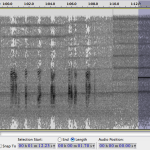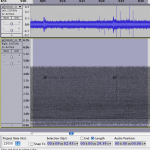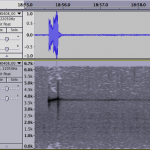Sonar in Haro Strait
With transient killer whales sighted in the vicinity yesterday and the whereabouts of the endangered southern residents unknown, we were surprised and concerned to hear active mid-frequency sonar and distorted underwater voices this evening in Haro Strait. Thankfully, the broken hydrophone at Lime Kiln State Park had been repaired just hours earlier by Beam Reach students and staff conducting a service project at The Whale Museum‘s acoustic laboratory that is housed within the light house. Eventually, Jeanne Hyde heard from the Coast Guard that we were likely listening to a U.S. Navy submarine. (4/9 update from Christopher Dunagan: the Navy confirms it was the USS San Francisco, a LA-class fast attack submarine which ran into a seamount near Guam in 2006. Since there was clearly damage to the sonar dome and it was replaced with the nose of decommissioned sub, I speculate that it was a higher priority of the Navy to test the sonar while still close to the ship yard than it was to go beyond the call of Naval duty to protect marine mammals.)
At 18:55 PST, Jeanne first reported someone “talking” into the Lime Kiln hydrophone of the Salish Sea Hydrophone Network. At 19:10, I started recording the Lime Kiln stream, capturing about 6 sequences of 5-10 distorted human words over about 11 minutes. The sequences seem to come every 1-3 minutes and begin with the same first few words and then vary in content and length. Most words had most of their power at 1.5-3.5kHz. About a minute and 15 seconds after the preceding word sequence, there was a 1.7-second tonal sonar ping at 2.9 kHz. At right is a screen grab from Audacity that shows the ping and the preceding word sequence. Here is a concatenation of the sequences and the ping: 090407_1910clips-lk_voice-sonar
Listening to both west side streams at around 19:15 it seemed that the voice and pings were louder at Lime Kiln, though they could be heard after a few second delay at the Orcasound hydrophone. By 21:00 it seemed the signals were louder at Orcasound than at Lime Kiln. This suggests that the Navy submarine was moving northward up Haro Strait. Since we have only a single hydrophone at each node and node-to-node timing isn’t synchronized in the streams, it’s not possible to verify the direction of travel using arrival time differences.
At 21:02 I made another recording from the Lime Kiln stream that contains two of the word sequences.  Then I switched to recording the Orcasound stream. The voice was clearly audible for the next half hour and there were a few sonar pings interspersed. By 21:34 the voice was pretty faint and the last time it’s dectable in the sonogram (and by ear, very faintly) is around 10:05. However, at about 21:59 the final recording caught a couple of unique pings (3.7-3.8kHz, 0.8 second) and their echoes ( 090407_2150_os_375khz-sonar ). The two pings were spaced 16 seconds apart and had a noticable echo at 3.67 seconds, equivalent to about 5.5 km. Assuming the echo was off the eastern wall of Haro Strait bathymetry (about 6km from Orcasound), the two-way travel time suggests the submarine was probably pretty close to the San Juan Island side of Haro Strait.
Longer, unedited recordings are available at http://orcasound.net — including:
- Lime Kiln stream recordings (scroll down to date in Flash player)
- Orcasound stream recordings (scroll down to date in Flash player)
- Lime Kiln automated recordings
- Orcasound automated recordings (sonar pings)
- John Boyd’s compilation of sonar sounds (Quicktime movie format)
- OrcaGirl’s stream recordings (start times not apparent)
The acoustic experience continued on past midnight. At 00:24:30 on 4/8/09 I heard a series of beeps (back at ~2.9 kHz) and then their echoes at Orcasound. At 00:30-00:32 I again recorded the voice along with tones and their echoes on the Lime Kiln stream. Around 00:40-00:45 I heard and recorded what sounded like a conversation, rather than the separated single words of the previous sequences. At 00:48:30 there was a very loud ping (close to Lime Kiln?) and either an echo or a ping from a separate, more distance location. This was followed by many repeated word sequences.   At 01:00 things got quiet, but then at 01:11:00 there was suddently another impressive single ping (sound clip: 090408_0038_lk_single-375khz-ping ). At 01:13, the slow voice started repeating sequences again. Another single ping came at ~01:22 as two cargo ships came abeam of Lime Kiln and increased the ambient noise levels. Another at 1:31:00 with a nice echo was followed by more conversing at 01:36. Then there was an extended sequence of sonar tones and verbal interjections that grew progressively fainter and then stopped ~01:45.  Around 01:50 things picked up again with more conversation and then — most interestingly — what sounded like an exchange of longer tones, possibly between two sources, one near Lime Kiln and one substantially further away. After about 5 minutes of silence, there were two more loud pings with echoes at 02:00:45.
Recordings made for much of the following hour, but I think I missed two loud pings at ~02:53:00. More pings heard at: 03:11…






 Twitter
Twitter LinkedIn
LinkedIn Facebook
Facebook
scott
April 8th, 2009 at 13:59
From orcanetwork.org
HI Scott –
Thanks for this – interesting stuff. Not sure if it’s related, but we’ve noticed 2 CG cutters in S. Saratoga Passage over the last 3 days, & increased Navy chopper traffic over the passage last night (4/7)…. wanted to send to you this short blurb noting the whale sightings we had from late yesterday afternoon not far from the area of sonar activity:
Also, you might be interested in this article we received a link to last night, just before the sonar incident:
http://news.yahoo.com/s/afp/20090407/sc_afp/scienceanimalscetaceanssonar
Thanks for your good work –
Susan
scott
April 8th, 2009 at 14:49
There is a meeting tomorrow at Port Townsend regarding the Navy expansion:
http://ptmarinesciencecenter.blogspot.com/2009/04/unusual-sounds-on-hydrophones.html
scott
April 8th, 2009 at 15:28
From Rachel Griffin, a bit about the harmonics relative to orca hearing sensitivity:
http://www.youtube.com/watch?v=LiuTxpgMQGU
scott
April 9th, 2009 at 11:26
Here’s a nice NPR piece on the incident by Liam Moriarty of KPLU:
http://www.publicbroadcasting.net/kplu/news.newsmain?action=article&ARTICLE_ID=1491428
scott
April 9th, 2009 at 23:58
Thanks to Susan Berta and Howard Garrett of http://orcanetwork.org for these links to press related to the incident:
Video from King5 News with interview clips of Fred Felleman:
http://www.nwcn.com/statenews/washington/stories/NW_040909WAB-sonar-submarine-KS.bb31ad35.html
Richard Walker’s article in the San Juan Journal:
http://www.pnwlocalnews.com/sanjuans/jsj/news/42687767.html
Brief coverage by Q13 Fox:
http://www.q13fox.com/pages/news_story_landing_page/?Residents-Speak-Out-About-Navy-Sonar=1&blockID=263085&feedID=144
scott
April 10th, 2009 at 15:14
An AP piece in the Everett Herald mentions that the Navy “didn’t enter Haro Strait and used trained lookouts, passive sonar and other measures to detect marine mammals.”
http://www.heraldnet.com/article/20090410/NEWS03/704109846
scott
April 12th, 2009 at 23:17
Seattle Times picks up the AP wire:
http://www.seattlepi.com/local/6420ap_wa_navy_sonar.html
scott
April 13th, 2009 at 15:43
NPR/KUOW piece that quotes Whale Museum Board Chair Val Veirs and Navy spokeswoman, Commander Dora Lockwood:
http://kuow.org/program.php?id=17314
http://indemand.nwpr.wsu.edu/NWPR/HomepageArticles/audio/041309Sonar.mp3
Lockwood stated “The Navy takes absolutely every effort to ensure that marine mammals are not in the area in which they’re operating…. They have watch standers that look for marine mammals in the area and they’re continuously listening for any type of marine life using passive sonar.”
The piece mentions that “She says the Navy followed standard safety precautions during Tuesday night’s training exercises.”
scott
April 14th, 2009 at 01:41
My sleep-deprived comments to the Navy regarding the Northwest Training Range Complex expansion DEIS:
“Dear sir or madam,
My main concern is balancing the priorities of training our Sailors and recovering the southern resident killer whale population, the regional icon of the Pacific Northwest.
As important as training is to the Navy, I urge you to amend all of the Alternatives with the following modifications:
— If training with active sonar is deemed essential within the inland waters of Washington State, use Hood Canal which the (now endangered) southern resident killer whales generally do not enter.
— Otherwise, summertime training (April through October) should be conducted on the outer coast at times when J, K, and L pods are known to be within the inland waters of Washington State and British Columbia.
— If wintertime training must occur within the inland waters outside of Hood Canal, coordinate with civilian sighting and listening networks until it is established without doubt that the southern residents will remain at a range from the testing of greater than 20nm.
— Fund the operation of third-party (civilian, grassroots) listening and sighting networks in all areas where training will occur.
— Share all declassified information available regarding the presence/absence of SRKWs based on Navy visual and acoustic observations to improve NOAA/NMFS understanding of habitat use, particularly in the outer coastal zone during the wintertime.”
scott
April 27th, 2009 at 16:34
From http://orcanetwork.org/ —
“Mark Malleson of Prince of Whales called with some good news – they found all the Transients that were in the Strait of Juan de Fuca on April 7th when sonar was used in the Strait, were present today! At about 3:10 pm, off the Dungeness Lighthouse heading east, they ID’d these Transient orcas: T30s’, T172, T49A’s. T14, plus T11 and T11A (who were not present on the 7th). “